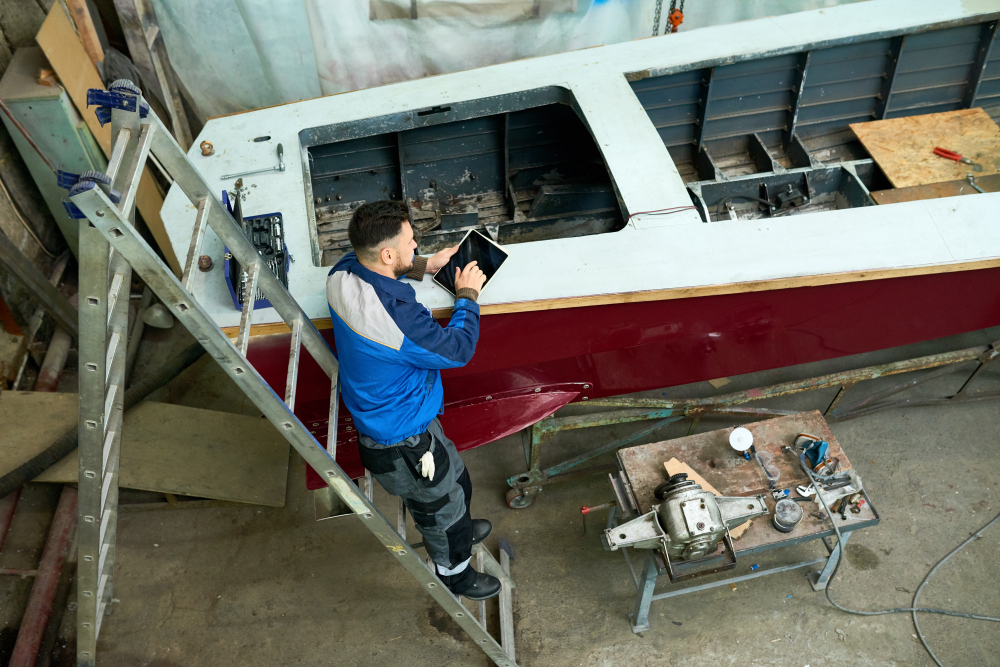Powerboat Maintenance and Safety Made Simple

For those who own or operate offshore powerboats, ensuring consistent maintenance and prioritizing safety are essential steps to enjoying a flawless experience on the water. Powerboats, crafted to deliver high-speed thrills and cutting-edge performance, require careful attention to keep them in top condition.
Whether you're an experienced captain or new to offshore boating, this guide will walk you through the essential aspects of powerboat maintenance, safety measures, and how choosing reputable powerboat companies, like Velocity Powerboats, can set you up for long-term success on the water.
Why Powerboat Maintenance is Non-Negotiable
Powerboats are engineered for performance, but regular upkeep ensures their efficiency, reliability, and longevity. Neglecting maintenance can lead to reduced performance, costly repairs, or worse, safety hazards. Here’s why prioritizing maintenance is crucial:
- Ensures Optimal Performance: Proper care keeps your engine powerful and your hull streamlined for peak performance.
- Prevents Expensive Repairs: Regular maintenance helps identify minor issues before they escalate into costly problems.
- Boosts Resale Value: A well-maintained boat retains higher market value over time.
- Improves Safety: Faulty systems or wear and tear increase the risk of accidents. Consistent maintenance minimizes those risks.
Powerboat Maintenance Checklist
To maintain your powerboat in top condition, follow this checklist of critical upkeep tasks:
1. Inspect the Engine Regularly
The engine is the heart of your powerboat and demands consistent care.
- Check and replace engine oil as per manufacturer recommendations.
- Inspect fuel and air filters, and replace them when necessary.
- Ensure the cooling system operates efficiently and is free of blockages.
- Test the engine’s ignition and electrical systems for faults.
2. Clean the Hull
A powerboat’s hull is exposed to marine elements that can lead to wear and friction if not cleaned regularly.
- Remove debris, salt buildup, and algae to maintain its integrity.
- Check for any cracks, scratches, or structural issues in the hull.
3. Lubricate Key Components
Lubricating key parts ensures smooth operation and prolongs their lifespan.
- Focus on the shaft, bearings, propeller parts, and steering mechanisms.
4. Inspect the Propeller
The propeller plays a vital role in performance.
- Look for dents, dings, or deformities that could affect speed or fuel efficiency.
- Ensure the propeller shaft is free of debris.
5. Test Electrical Systems
Electrical systems power essential components like navigation lights, GPS, and communication devices.
- Look for corroded connections or worn-out wiring and replace damaged components.
- Ensure backup batteries are fully charged.
6. Update Safety Equipment
Inspect all safety equipment to guarantee compliance with regulations and readiness in case of emergencies.
- Check life jackets, fire extinguishers, and first-aid kits to ensure they’re functional and not expired.
- Test signal flares, horns, and navigation lights for usability.
Safety Measures for Powerboat Operators
When operating a high-speed powerboat, safety should always come first. Here are key practices to ensure a safe voyage:
1. Conduct a Pre-Departure Inspection
Before heading out, take time to review the following essentials:
- Ensure fuel and oil levels are sufficient.
- Check weather forecasts to avoid unfavorable conditions.
- Ensure all safety equipment is onboard and easily accessible.
2. Adopt Safe Driving Practices
Speed and adrenaline are part of the thrill of owning a powerboat, but responsible driving keeps everyone safe.
- Operate at a safe and controllable speed for the conditions.
- Be aware of your surroundings and stay mindful of other boats.
- Follow local boating laws, including speed limits and restricted zones.
3. Prioritize Training and Certification
Before navigating offshore waters, ensure you have the necessary certifications and skills.
- Take approved boating safety courses to familiarize yourself with navigation, communication protocols, and emergency response.
- Practice docking, turning, and handling rough waves in controlled environments before extensive trips.
4. Stay Connected
Reliable communication is critical in emergencies. Always have the following onboard:
- A marine VHF radio for communication.
- Backup GPS systems in case one device malfunctions.
- Emergency contact numbers specific to your boating region.
Why Choose Reputable Powerboat Companies
When it comes to investing in your boat’s long-term performance and safety, choosing trusted powerboat companies is an invaluable step. Here’s what sets companies like Velocity Powerboats apart:
Expert Craftsmanship
Velocity Powerboats designs their vessels for premium speed, comfort, and safety. A well-built powerboat minimizes the need for frequent repairs and enhances your experience on the water.
Exceptional Customer Support
You should expect thorough guidance when selecting a model, as well as clear maintenance tips and safety guidelines after purchase. Companies like Velocity Powerboats prioritize ensuring their customers feel confident every step of the way.
Advanced Safety Features
High-performance powerboats often come with specialized safety components, designed to reduce risks even at high speeds.
Trusted Industry Reputation
Long-standing powerboat companies have strong reputations and customer trust, ensuring you’re making the right choice for your boating lifestyle.
Common Questions About Powerboat Maintenance
How often should I service my powerboat?
Routine maintenance, including oil changes and hull inspections, is recommended after every 50 engine hours or at least annually, depending on usage frequency.
Do I need a professional for maintenance?
While routine cleaning and basic tasks can be done by owners, engine inspections and electrical checks should be left to certified professionals for safety and efficiency.
What’s the lifespan of a well-maintained powerboat?
With proper care, powerboats from reputable companies like Velocity Powerboats can last 15 to 30 years, depending on usage and upkeep.
Set Sail with Confidence
Proper powerboat maintenance and prioritizing safety aren’t just about keeping your boat in excellent condition; they ensure you get the most out of your time on the water. By following the tips outlined above, you’ll enjoy smoother rides, reduced risks, and a greater peace of mind.
If you’re ready to upgrade to a high-performance powerboat or want expert advice on maintenance, get in touch with Velocity Powerboats today. Experience the ultimate blend of speed, safety, and style.